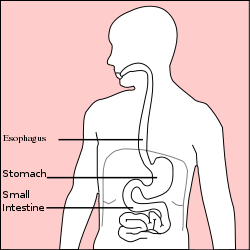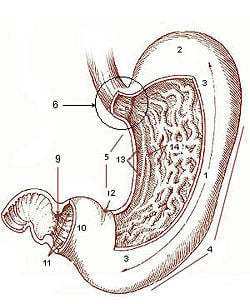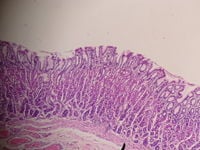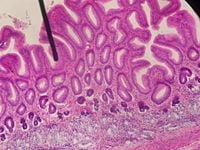Difference between revisions of "Stomach" - New World Encyclopedia
Jyoti Sharma (talk | contribs) |
Jyoti Sharma (talk | contribs) |
||
| Line 67: | Line 67: | ||
{| class="wikitable" | {| class="wikitable" | ||
| − | | | + | | mucosa || the first main layer; this consists of an epithelium, the lamina propria underneath, and a thin layer of smooth muscle called the muscularis mucosae. |
|- | |- | ||
| − | | | + | | submucosa || this layer lies under the mucosa and consists of fibrous connective tissue, which separates the mucosa from the next layer; the Meissner's plexus is in this layer. |
|- | |- | ||
| − | | | + | | muscularis externa || |
| − | + | located under the submucosa; the muscularis externa in the stomach differs from that of<!--parallelism, PLEASE—> other GI organs in that it has three layers of smooth muscle instead of two. | |
| − | * ''inner oblique layer:'' This layer is responsible for creating the motion that churns and physically breaks down the food. It is the only layer of the three which is not seen in other parts of the [[digestive system]]. The antrum has thicker skin | + | * ''inner oblique layer:'' This layer is responsible for creating the motion that churns and physically breaks down the food. It is the only layer of the three which is not seen in other parts of the [[digestive system]]. The antrum has thicker skin [[cell]]s in its walls and performs more forceful contractions than the fundus. |
| − | * ''middle circular layer:'' At this layer, the | + | * ''middle circular layer:'' At this layer, the pylorus is surrounded by a thick circular muscular wall which is normally tonically constricted forming a functional (if not anatomically discrete) pyloric sphincter, which controls the movement of [[chyme]] into the duodenum. This layer is concentric to the longitudinal axis of the stomach. |
| − | * ''outer longituditinal layer:'' | + | * ''outer longituditinal layer:'' Auerbach's plexus is found between this layer and the middle circular layer. |
|- | |- | ||
| − | | | + | | serosa || This layer is under the muscularis externa, consisting of layers of connective tissue continuous with the peritoneum. |
|} | |} | ||
[[Image:Stomach.JPG|thumb|200px|Cross section of stomach wall.]] | [[Image:Stomach.JPG|thumb|200px|Cross section of stomach wall.]] | ||
| Line 88: | Line 88: | ||
{| class="wikitable" | {| class="wikitable" | ||
| − | | ''' | + | | '''Cardiac glands'''<BR>(at cardia) || '''Pyloric glands'''<BR>(at pylorus) || '''Fundic glands'''<BR>(at fundus) |
|- | |- | ||
| [[Image:Gray1053.png|100px]] || [[Image:Gray1054.png|100px]] || [[Image:Gray1055.png|100px]] | | [[Image:Gray1053.png|100px]] || [[Image:Gray1054.png|100px]] || [[Image:Gray1055.png|100px]] | ||
| Line 98: | Line 98: | ||
| '''Layer of stomach''' || '''Name''' || '''Secretion''' || '''Region of stomach''' || '''Staining''' | | '''Layer of stomach''' || '''Name''' || '''Secretion''' || '''Region of stomach''' || '''Staining''' | ||
|- | |- | ||
| − | | Isthmus of gland || [[ | + | | Isthmus of gland || goblet [[cell]]s || mucus gel layer || Fundic, cardiac, pyloric || Clear |
|- | |- | ||
| − | | Neck of gland | | + | | Neck of gland || parietal (oxyntic) cells || gastric acid and intrinsic factor || Fundic, cardiac, pyloric || Acidophilic |
|- | |- | ||
| − | | Base of gland || | + | | Base of gland || gastric/chief (zymogenic) cells || pepsinogen, rennin || Fundic only || Basophilic |
|- | |- | ||
| − | | Base of gland | | + | | Base of gland || enteroendocrine (APUD) cells || [[hormones]] || Fundic, cardiac, pyloric || - |
|} | |} | ||
==Control of secretion and motility== | ==Control of secretion and motility== | ||
| − | The movement and the flow of chemicals into the stomach are controlled by both the [[autonomic nervous system]] and by the various digestive system [[hormone]]s: | + | The movement and the flow of chemicals into the stomach are controlled by both the [[autonomic nervous system]] and by the various digestive system [[hormone]]s. The autonomic nervous system acts as a control system, maintaining homeostasis in the body. These maintenance activites are primarily performed without conscious control or sensation. |
| + | |||
| + | The various digestive system hormones include: | ||
{| class="wikitable" | {| class="wikitable" | ||
| − | | | + | | Gastrin || The hormone ''gastrin'' causes an increase in the secretion of hydrochloric acid (HCl), pepsinogen, and intrinsic factor (from parietal [[cell]]s) in the stomach. It also causes increased motility in the stomach. Gastrin is released by G-cells in the stomach to distenstion of the antrum and digestive products. It is inhibited by a [[pH]] normally less than 4 (high acid), as well as the hormone somatostatin. |
|- | |- | ||
| − | | | + | | Cholecystokinin || ''Cholecystokinin'' (CCK) has most effect on the [[gall bladder]], but it also decreases gastric emptying. |
|- | |- | ||
| − | | | + | | Secretin || In a different and rare manner, ''secretin'', produced in the small intestine, has most effects on the [[pancreas]], but will also diminish acid secretion in the stomach. |
|- | |- | ||
| − | | | + | | Gastric inhibitory peptide || ''Gastric inhibitory peptide'' (GIP) decreases both gastric acid and motility. |
|- | |- | ||
| − | | | + | | Enteroglucagon || ''Enteroglucagon'' decreases both gastric acid and motility. |
|} | |} | ||
| − | Other than gastrin, these hormones all act to turn off the stomach action. This is in response to food products in the liver and gall bladder, which have not yet been absorbed. The stomach needs only to push food into the small intestine when the intestine is not busy. While the intestine is full and still digesting food, the stomach acts as storage for food. | + | Other than gastrin, these hormones all act to turn off the stomach action. This is in response to food products in the [[liver]] and gall bladder, which have not yet been absorbed. The stomach needs only to push food into the small intestine when the intestine is not busy. While the intestine is full and still digesting food, the stomach acts as storage for food. |
==Diseases of the stomach== | ==Diseases of the stomach== | ||
| − | * | + | * Dyspepsia |
| − | * | + | * Stomach ache |
| − | * | + | * Peptic ulcer |
| − | * | + | * Achlorhydria |
| − | * | + | * Hypochlorhydria |
| − | * | + | * Linitis plastica |
| − | * | + | * Zollinger-Ellison syndrome |
| − | * | + | * Gastroparesis |
| − | * | + | * Gastroesophageal reflux disease (GERD) |
| − | * | + | * Borborygmus |
| − | Historically, it was widely believed that the highly acidic environment of the stomach would keep the stomach immune from | + | Historically, it was widely believed that the highly acidic environment of the stomach would keep the stomach immune from infection. However, a large number of studies have indicated that most cases of stomach ulcers, gastritis, and stomach [[cancer]] are caused by the ''Helicobacter pylori'' infection. One of the ways it is able to survive in the stomach involves its urease enzymes. These metabolize [[urea]], which is normally secreted into the stomach, to [[ammonia]] and [[carbon dioxide]], both of which neutralize gastric acid and thus prevents its digestion. In recent years, it has been discovered that other ''Helicobacter'' bacteria are also capable of colonizing the stomach and have been associated with gastritis. |
| − | Having too little or no gastric acid is known as | + | Having too little or no gastric acid is known as ''hypochlorhydria'' or ''achlorhydria'', respectively, and are conditions which can have negative health impacts. Having high levels of gastric acid is called ''hyperchlorhydria''. Many people believe that hyperchlorhydria can cause stomach ulcers. However, recent research indicates that the gastric mucosa which secretes gastric acid is acid-resistant. |
==Differences among animals== | ==Differences among animals== | ||
| Line 152: | Line 154: | ||
{{wiktionary}} | {{wiktionary}} | ||
* [http://www.med.uiuc.edu/m1/biochemistry/TA%20reviews/sam/AminoAcids.htm Digestion of proteins in the stomach] | * [http://www.med.uiuc.edu/m1/biochemistry/TA%20reviews/sam/AminoAcids.htm Digestion of proteins in the stomach] | ||
| − | |||
| − | |||
| − | |||
{{Digestive tract}} | {{Digestive tract}} | ||
Revision as of 02:50, 13 July 2007
| Stomach | |
|---|---|
| The location of the stomach in the body. | |
| Diagram from cancer.gov: * 1. Body of stomach * 2. Fundus * 3. Anterior wall * 4. Greater curvature * 5. Lesser curvature * 6. Cardia * 9. Pyloric sphincter * 10. Pyloric antrum * 11. Pyloric canal * 12. Angular notch * 13. Gastric canal * 14. Rugal folds Work of the United States Government | |
| Latin | Ventriculus |
| Gray's | subject #247 1161 |
| Nerve | celiac ganglia, vagus[1] |
| Lymph | celiac preaortic lymph nodes[2] |
| MeSH | Stomach |
| Dorlands/Elsevier | g_03/12386049 |
In anatomy, the stomach is a bean-shaped hollow muscular organ of the gastrointestinal tract involved in digestion. The stomach serves as a sac for interim food storage and it also initiates the food breakdown process. Stomachs are found in both vertebrates and invertebrates. The structure and size of the stomach vary within vertebrates. It can be a simple tube resembling other parts of the gastrointestinal tract as found in some primitive vertebrates while in other vertebrates it is a definite structure. Several invertebrates also have a similar digestive organ. In birds, for example, the stomach is made up of a proventriculus and a gizzard, both which work together in digestion.
In humans, the stomach is located in the abdomen between the esphagus and the small intestine, just below the diaphragm. It is a complex organ made up of several layers of membranes and different kinds of cells.
The word stomach is derived from the Latin stomachus, which derives from the Greek word stomachos (στόμαχος). The words gastro- and gastric (meaning related to the stomach) are both derived from the Greek word gaster (γαστήρ).
Functions and Actions
The stomach serves an important role in digestion. It has three main functions: temporarily hold and store food, begin to breakdown macromacules (usually food) into smaller parts, and absorb certain molecules.
Food passes down from the esophagus into the stomach. According to the body's needs, the stomach begins to breakdown the macromacules. The stomach is able to achieve this due to its highly acidic environment. The production and secretion of gastric acid produces a luminal pH range anywhere between 1 and 4, depending on the species, food intake, time of the day, drug use, and other factors. Such an environment enables the stomach to break down large molecules into smaller ones so that they can eventually be absorbed by the small intestine. The stomach can produce and secrete about 2 to 3 liters of gastric acid per day with secretion levels peaking during the evening hours for humans.
Assisting the acidic environment of the stomach are the various cells of the stomach, which release secretions that aide in molecule breakdown and digestion. Pepsinogen is secreted by chief cells and turns into pepsin under low pH conditions. It is a necessity in protein digestion. Absorption of vitamin B12 from the small intestine is dependent on conjugation to a glycoprotein called intrinsic factor which is produced by parietal cells of the stomach. Other functions include absorbing some ions, water, and some lipid soluble compounds such as alcohol, aspirin, and caffeine.
Another function of the stomach is simply as a food storage cavity.
Anatomy of the human stomach
The stomach lies between the esophagus and the duodenum (the first part of the small intestine). It is on the left side of the abdominal cavity. The top of the stomach lies against the diaphragm. Lying beneath the stomach is the pancreas and the greater omentum, which hangs from the greater curvature.
Two smooth muscle valves, or sphincters, keep the contents of the stomach contained. The esophageal sphincter is found in the cardiac region and divides the tract from the esophagus, and the pyloric sphincter divides the stomach from the small intestine.
The stomach is surrounded by parasympathetic (stimulant) and orthosympathetic (inhibitor) peluxes (anterior gastric, posterior, superior and inferior, celiac and myenteric), which regulate both the secretory activity and the motor activity of the muscles.
In humans, the stomach has a volume of about 50 mL when empty. After a meal, it generally expands to hold about 1 liter of food, [3] but it can actually expand to hold as much as 4 liters. When drinking milk it can expand to just under 6 pints, or 3.4 liters. [4]
Sections
The stomach is divided into four sections, each of which has different cells and functions. The sections are:
| Cardia | where the contents of the esophagus empty into the stomach |
| Fundus | formed by the upper curvature of the organ |
| Body or corpus | the main, central region |
| Pylorus or antrum | the lower section of the organ that facilitates emptying the contents into the small intestine |
Blood supply
The lesser curvature of the stomach is supplied by the right gastric artery inferiorly, and the left gastric artery superiorly, which also supplies the cardiac region. The greater curvature is supplied by the right gastroepiploic artery inferiorly and the left gastroepiploic artery superiorly. The fundus of the stomach, and also the upper portion of the greater curvature, are supplied by the short gastric artery.
Histology of the human stomach
Layers
Like the other parts of the gastrointestinal tract, the stomach walls are made of the following layers, from inside to outside:
| mucosa | the first main layer; this consists of an epithelium, the lamina propria underneath, and a thin layer of smooth muscle called the muscularis mucosae. |
| submucosa | this layer lies under the mucosa and consists of fibrous connective tissue, which separates the mucosa from the next layer; the Meissner's plexus is in this layer. |
| muscularis externa |
located under the submucosa; the muscularis externa in the stomach differs from that of other GI organs in that it has three layers of smooth muscle instead of two.
|
| serosa | This layer is under the muscularis externa, consisting of layers of connective tissue continuous with the peritoneum. |
Glands
The epithelium of the stomach forms deep pits. The glands at these locations are named for the corresponding part of the stomach:
| Cardiac glands (at cardia) |
Pyloric glands (at pylorus) |
Fundic glands (at fundus) |
 |
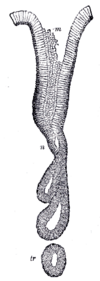 |
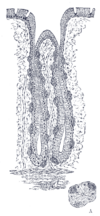
|
Different types of cells are found at the different layers of these glands:
| Layer of stomach | Name | Secretion | Region of stomach | Staining |
| Isthmus of gland | goblet cells | mucus gel layer | Fundic, cardiac, pyloric | Clear |
| Neck of gland | parietal (oxyntic) cells | gastric acid and intrinsic factor | Fundic, cardiac, pyloric | Acidophilic |
| Base of gland | gastric/chief (zymogenic) cells | pepsinogen, rennin | Fundic only | Basophilic |
| Base of gland | enteroendocrine (APUD) cells | hormones | Fundic, cardiac, pyloric | - |
Control of secretion and motility
The movement and the flow of chemicals into the stomach are controlled by both the autonomic nervous system and by the various digestive system hormones. The autonomic nervous system acts as a control system, maintaining homeostasis in the body. These maintenance activites are primarily performed without conscious control or sensation.
The various digestive system hormones include:
| Gastrin | The hormone gastrin causes an increase in the secretion of hydrochloric acid (HCl), pepsinogen, and intrinsic factor (from parietal cells) in the stomach. It also causes increased motility in the stomach. Gastrin is released by G-cells in the stomach to distenstion of the antrum and digestive products. It is inhibited by a pH normally less than 4 (high acid), as well as the hormone somatostatin. |
| Cholecystokinin | Cholecystokinin (CCK) has most effect on the gall bladder, but it also decreases gastric emptying. |
| Secretin | In a different and rare manner, secretin, produced in the small intestine, has most effects on the pancreas, but will also diminish acid secretion in the stomach. |
| Gastric inhibitory peptide | Gastric inhibitory peptide (GIP) decreases both gastric acid and motility. |
| Enteroglucagon | Enteroglucagon decreases both gastric acid and motility. |
Other than gastrin, these hormones all act to turn off the stomach action. This is in response to food products in the liver and gall bladder, which have not yet been absorbed. The stomach needs only to push food into the small intestine when the intestine is not busy. While the intestine is full and still digesting food, the stomach acts as storage for food.
Diseases of the stomach
- Dyspepsia
- Stomach ache
- Peptic ulcer
- Achlorhydria
- Hypochlorhydria
- Linitis plastica
- Zollinger-Ellison syndrome
- Gastroparesis
- Gastroesophageal reflux disease (GERD)
- Borborygmus
Historically, it was widely believed that the highly acidic environment of the stomach would keep the stomach immune from infection. However, a large number of studies have indicated that most cases of stomach ulcers, gastritis, and stomach cancer are caused by the Helicobacter pylori infection. One of the ways it is able to survive in the stomach involves its urease enzymes. These metabolize urea, which is normally secreted into the stomach, to ammonia and carbon dioxide, both of which neutralize gastric acid and thus prevents its digestion. In recent years, it has been discovered that other Helicobacter bacteria are also capable of colonizing the stomach and have been associated with gastritis.
Having too little or no gastric acid is known as hypochlorhydria or achlorhydria, respectively, and are conditions which can have negative health impacts. Having high levels of gastric acid is called hyperchlorhydria. Many people believe that hyperchlorhydria can cause stomach ulcers. However, recent research indicates that the gastric mucosa which secretes gastric acid is acid-resistant.
Differences among animals
In ruminants, such as bovines, the stomach is a large multichamber organ which hosts symbiotic bacteria that produce enzymes required for the digestion of cellulose from plant matter. The partially digested plant matter passes through each of the intestine chambers in sequence, being regurgitated and rechewed at least once in the process.
In some animals (such as cats and dogs), the pH of the lumen is lower, usually between 1 and 2. In contrast, the human stomach pH is usually between 2 and 3.
ReferencesISBN links support NWE through referral fees
- ↑ Physiology at MCG 6/6ch2/s6ch2_30
- ↑ Norman/Georgetown stomach
- ↑ Sherwood, Lauralee (2004) Human Physiology - From Cells to Systems (International Student Edition, 5th ed) p604 Books/Cole - Thomson Learning ISBN 0-534-39536-8
- ↑ Saladin, Kenneth S. (2004) "Anatomy & Physiology - The Unity of Form and Function" (International Edition, 3rd ed) p950 - The McGraw Hill Companies ISBN 0-07-242903-8
External links
| ||||||||||||||||||||
Credits
New World Encyclopedia writers and editors rewrote and completed the Wikipedia article in accordance with New World Encyclopedia standards. This article abides by terms of the Creative Commons CC-by-sa 3.0 License (CC-by-sa), which may be used and disseminated with proper attribution. Credit is due under the terms of this license that can reference both the New World Encyclopedia contributors and the selfless volunteer contributors of the Wikimedia Foundation. To cite this article click here for a list of acceptable citing formats.The history of earlier contributions by wikipedians is accessible to researchers here:
The history of this article since it was imported to New World Encyclopedia:
Note: Some restrictions may apply to use of individual images which are separately licensed.
